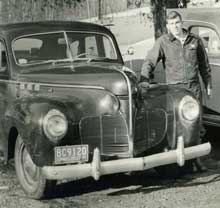Hernando
I thought I knew all the cars of the 1930s, '40s and '50s - I'd been carspotting ever since I could remember. But the summer I turned 16 I came across one I'd not seen before. The grille was like that of the 1940 Pontiac, but different, in an attractive sort of way. A look at the nameplate showed me it was a DeSoto, a 1940 Custom sedan. It was parked at a gas station, for sale, and the price was a moderate (even then) $30. I had to have it.
So have it I did. I paid my $30 to the owner, who worked at the station and had traded up to a newer Studebaker Commander, borrowed a set of dealer plates, and my friend Gene, who was six months older and already had a license, drove it home for me.
I was elated. I named it "Hernando" for reasons that will be obvious to most CarPorters. The black paint was in fairly good shape, and both it and the chrome polished up well. On the other hand, the fact that we had to tow it to get it started was not encouraging, nor was the fact that the engine's casting plugs were weeping water, which the owner had tried to fix by filling them with window putty...
One of the rear wheel cylinders leaked, which I repaired without much trouble. The engine did not run evenly, though, and a compression check showed the rear two cylinders had none. "It needs a valve job," I decided (it was my valve job period, when all ills could be cured with a valve job). When I got the head off, I found the gasket was blown through between the two cylinders, which had also caused a water leak, which in turn had rusted a head bolt that broke when I tried to remove it.
There was also a burned exhaust valve on the front cylinder, so I bought a new valve, along with a head gasket, from the local DeSoto dealer. "Gawd," said the parts man, "that's 20 years old!" I thanked him for his wisdom.
More ominous than the burned valve was a chunk missing from the front piston. It hadn't scored the cylinder and I didn't relish dropping the pan to change it, so I put things back as best I could, drilled out the broken bolt, retapped the hole and buttoned it up. The engine ran better than before, though not as well as I'd hoped, and seemed to run a little hot.
Hernando looked good, though, all polished up. I painted the wheels red, imitating a treatment on 1950 Buicks that I liked, and bought a set of Port-o-Walls. I also attempted to dye the brown cloth seats red, not successfully as they came out a shade of purple. Still, I thought Hernando was handsome and got him properly registered for the road.
The first time I drove Hernando some distance, he blew out the weeping casting plug, and I had to retreat home while losing most of the water, which didn't seem to cause permanent damage. I replaced the plug with a bolt-in type. The car bounced badly - the shocks were shot - but the radio made lovely music, with deep booming bass notes and the Safety Signal speedometer changed color as the car went faster. After a few weeks, though, the engine began to make suspicious noises. I retreated to the Nash Rambler convertible that had been handed down by my mother, and left Hernando to sit outside the barn. We put the Port-o-Walls on my friend Tod's 1936 Plymouth, and the radio went into his Crosley. Over time, I parted Hernando out, fenders and bumpers to Texas, hubcaps to Massachusetts - and I've still got a few bits left.
It could be argued that I'd made a bad choice, thrown my money away because Hernando gave me so few miles for my investment. But I'd learned a lot, spent little more than $100 and had a good time doing it. Besides, Hernando had helped restore a number of other 1940 DeSotos. After all, that's what it's all about.

